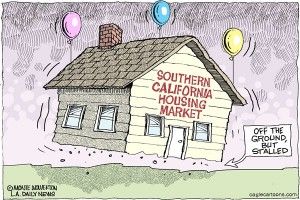High housing costs slug CA
by John Seiler | June 28, 2014 8:15 am
 Another report details how housing costs continue to slug Californians. From the Bee:[1]
Another report details how housing costs continue to slug Californians. From the Bee:[1]
Except for those living in the state’s most remote rural areas, Californians must contend with the nation’s highest housing costs, both rental and ownership, relative to their incomes, a new nationwide study by Harvard University’s Joint Center for Housing Studies reveals.
The massive report underscores a Census Bureau conclusion that when the cost of living, particularly housing, is included, California has the nation’s highest rate of poverty, with nearly a quarter of its residents impoverished.
Conversely, San Franciscans have higher housing costs than Angelenos, but their incomes are much higher, proportionately, so the San Francisco-Oakland area is No. 32 on the housing burden list with 42.7 percent of its households having “cost burdens.”
I rent in Orange County and it’s so preposterously expensive here I’m considering getting out. But where to? If I leave the expensive coastal areas, I might as well go to Vegas where there’s no income tax and the chance of seeing Elvis.
Why
There are a number of reasons for this. As I’ve noted[2], the California Coastal Commission severely limits construction along the coasts. Lower supply means higher costs.
But another reason is what’s called LAFCOs: local area formation commissions. Randal O’Toole explained[3]:
Thanks to land-use planning and regulation, California has the least-affordable housing in the nation. The most affordable housing market in California is less affordable than 90 percent of the other housing markets in the U.S. These high prices impose hardships on low- and middle-income families and discourage employers from locating in the state.
Under the mantra of “stopping sprawl,” urban planners have crammed nearly 95 percent of Californians into just 5.1 percent of the state’s land area. The nation’s three densest urban areas, and 11 of the 20 densest urban areas, are all in California. Thanks to urban-growth boundaries, greenbelts and other planning restrictions, the average California urbanite lives in communities that are 80 percent denser than in the rest of the country.
In addition to extraordinarily high housing prices, this density drives up business costs, taxes and traffic congestion.
LAFCOs trap taxpayers
It wasn’t always this way. In the 1960s, California was growing much faster than it is today, yet housing was no more expensive than in most other parts of the country. California was growing so fast that cities often competed with one another over which would get to annex (and collect taxes on) land suitable for development.
To minimize such competition, in 1963 the California Legislature created a local area formation commission (LAFCO) for each county. These commissions could approve or veto the formation of new cities or special service districts and annexations to those cities or districts. Most commissions were dominated by representatives of the city councils in each county.
The cities soon realized they could use LAFCOs to keep most taxpayers within their boundaries. No longer could a developer build houses on vacant land outside of a city’s limits and incorporate a new city or service district to provide the water, sewer and other infrastructure needs for those homes.
After eliminating the competition from such developments, cities could impose costly and time-consuming planning restrictions that further drove up housing costs. What was portrayed in public as a war on sprawl was, in reality, a war on taxpayers seeking to escape the high tax rates imposed by cities.
Basically, that means the only way you can afford to be in the middle class in California is if you bought a home before about 2000. Otherwise, you can afford to live here only if you’re rich, or if you’re on welfare and get Section 8 government housing.
As Yoga Berra might put it: The middle class can afford to live in California only if it leaves.
- From the Bee:: http://blogs.sacbee.com/capitolalertlatest/2014/06/californians-cope-with-nations-highest-housing-cost-burdens.html
- As I’ve noted: http://calwatchdog.com/2012/04/03/good-riddance-to-peter-douglas/
- Randal O’Toole explained: http://www.cato.org/publications/commentary/why-california-home-prices-are-so-high
Source URL: https://calwatchdog.com/2014/06/28/high-housing-costs-slug-ca/